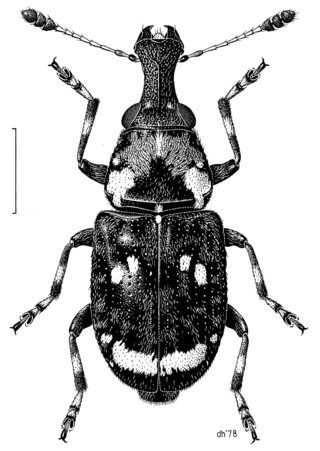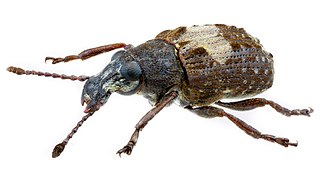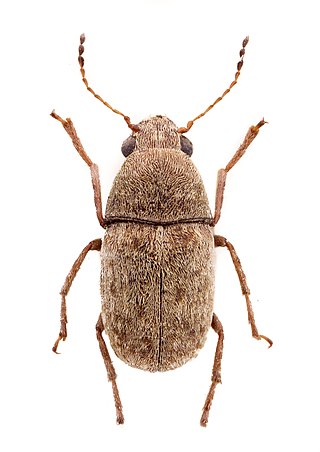
Weevils are beetles belonging to the superfamily Curculionoidea, known for their elongated snouts. They are usually small – less than 6 mm in length – and herbivorous. Approximately 97,000 species of weevils are known. They belong to several families, with most of them in the family Curculionidae. It also includes bark beetles, which while morphologically dissimilar to other weevils in lacking the distinctive snout, is a subfamily of Curculionidae. Some other beetles, although not closely related, bear the name "weevil", such as the biscuit weevil, which belongs to the family Ptinidae.

Anthribidae is a family of beetles also known as fungus weevils. The antennae are not elbowed, may occasionally be longer than the body and thread-like, and can be the longest of any members of Curculionoidea. As in the Nemonychidae, the labrum appears as a separate segment to the clypeus, and the maxillary palps are long and projecting.

Nemonychidae is a small family of weevils, placed within the primitive weevil group because they have straight rather than geniculate (elbowed) antennae. They are often called pine flower weevils. As in the Anthribidae, the labrum appears as a separate segment to the clypeus, and the maxillary palps are long and projecting. Nemonychidae have all ventrites free, while Anthribidae have ventrites 1-4 connate or partially fused. Nemonychidae lack lateral carinae on the pronotum, while these are usually present, though may be short, in Anthribidae.

Plegadis is a bird genus in the family Threskiornithidae. The genus name derives from Ancient Greek plegados, "sickle", referring to the distinctive shape of the bill. Member species are found on every continent except Antarctica as well as a number of islands.

Araecerus fasciculatus, the coffee bean weevil, is a species of beetle (Coleoptera) belonging to the family Anthribidae. Despite its name, it affects a wide range of stored products and some field crops and is accredited with consuming more than 100 different kinds of stored goods. This polyphagous insect is often found in stored crops such as: corn, cassava, sweet potatoes, nutmeg, dried fruits and various nuts. Through trade it has become cosmopolitan in its distribution and is considered an economically important global pest. A. fasciculatus causes significant damage to stored food goods, can result in loss of mass quantities of product and can reduce the quality of the stored goods.

Euparius is a genus of Fungus Weevils in the beetle family Anthribidae. There are more than 70 described species in Euparius, found in the Americas, Asia, Australia, and Africa.

Anthribinae is a subfamily of fungus weevils in the family of beetles known as Anthribidae. There are over 50 genera and more than 80 described species in Anthribinae.

Piesocorynus plagifer is a species of fungus weevils in the family Anthribidae. It is found in North America.

Piesocorynus is a genus of fungus weevils in the family Anthribidae. There are about 5 described species in Piesocorynus.
Piesocorynini is a tribe of fungus weevils in the family Anthribidae. There are at least 2 genera and about 8 described species in Piesocorynini.
Ormiscus sextuberculatus is a species of fungus weevil in the family Anthribidae. It is found in North America.
Eusphyrus eusphyroides is a species of fungus weevil in the family Anthribidae. It is found in North America.

Euparius marmoreus is a species of fungus weevil in the family of beetles known as Anthribidae. It is found in North America.

Gonotropis dorsalis is a species of fungus weevil in the family of beetles known as Anthribidae.

Gonotropis is a genus of fungus weevils in the family of beetles known as Anthribidae. There are about five described species in Gonotropis.

Euparius lugubris is a species of fungus weevil in the beetle family Anthribidae.

Choraginae is a subfamily of fungus weevils in the beetle family Anthribidae. There are about 9 genera and more than 180 described species in Choraginae.
Euparius pictus is a species of fungus weevil in the beetle family Anthribidae. It is found in Central America and North America.
Cyriopagopus paganus is a tarantula which was first described by Eugène Simon in 1887. They can be found in Thailand Vietnam, and Myanmar. They are burrowers, being found in this area, inside their burrows, waiting for prey.

Choerocoris paganus, also known as the red jewel bug, is a species of true bug in the family Scutelleridae. They are generally not harmful, but can exude noxious chemicals. They are found in woodlands and scrublands of Australia.












